Orchids- Adorn Your Home with These Delicate Dazzlers
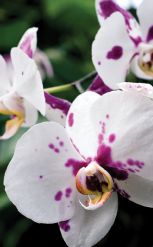
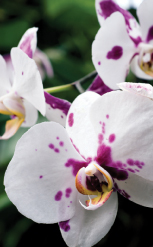 Simple. Elegant. Gracious and charming…these are conditions the consummate Southern hostess aims for in home and entertaining. How fitting that these qualities can also be attributed to orchids—the subtle plant adorning more and more homes in our area as their popularity takes hold. Once only a hobby for the wealthy, orchids are now widely available and affordable at the local florist, supermarket or even “big box” stores. An instant focal point, the orchid’s dainty petals can help you forget about the chilly weather outside and dream of tropical islands far away.
Simple. Elegant. Gracious and charming…these are conditions the consummate Southern hostess aims for in home and entertaining. How fitting that these qualities can also be attributed to orchids—the subtle plant adorning more and more homes in our area as their popularity takes hold. Once only a hobby for the wealthy, orchids are now widely available and affordable at the local florist, supermarket or even “big box” stores. An instant focal point, the orchid’s dainty petals can help you forget about the chilly weather outside and dream of tropical islands far away.
Orchids have immediate appeal for the elegance and warmth they can bring to any room, especially in winter. Potted in a favorite vase, a mature and well-cared-for orchid can loom over a fireplace, cascade over an end table or brighten up a windowsill. With a single stem bearing several beautiful blooms and a most delightful fragrance, the orchid has stage presence unlike any other flowering plant.
Orchids make great conversation pieces and have become a decorating staple in Southern homes. That’s why they make great gifts, too. Think birthdays, holidays—even weddings and new babies. For what better way to celebrate a new family than by giving an orchid, for each orchid is part of a family of over 30,000 natural and hybrid varieties—by far the largest family of flowering plants.
There’s a reason why you dream of the tropics when you spot an orchid. Many of them are native to tropical lands, where the right amount of light, the mild temperature and a gentle breeze cause an orchid to thrive. If you find yourself on the other end of the gift-giving, however, it’s not impossible to create those same conditions in your own home. All you need to do is get to know your plants, like you would do when tending to houseguests. Find out what they prefer to eat and where they are most comfortable lounging about. Then sit back and enjoy your company!
The American Orchid Society (AOS) offers tips for buying and caring for orchids:
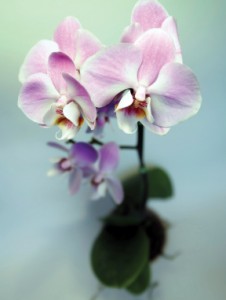 Purchasing Your Plant
Purchasing Your Plant
Modern reproductive methods have made it possible for growers to provide several reasonably priced orchids. The most widely-available orchids include the Phalaenopsis or “moth” orchid, because they grow well indoors, under the same conditions as African violets, as well as the Dendrobium, Oncidium and Miltonia varieties. You may also come across the Paphiopedilum, or the “lady slipper” orchid, that can rebloom, offering weeks of enjoyment.
When sorting through the selection, make sure the plant is in proportion to the container. Also check to make sure the roots are in the media and that the foliage is a light, yellowish green. Dark green leaves, though attractive on other houseplants, can signal that the orchid has not received sufficient light, which can hamper its efforts to rebloom.
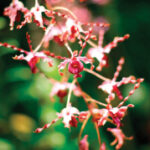 Just What the Orchid Ordered
Just What the Orchid Ordered
Water, food and air… necessities for life. But for orchids, an excess of any of these elements can cause damage. In fact, overwatering is the main cause of an orchid’s demise. AOS gives this classic advice: water the day before the plant dries out. The only way you will know this is by experimenting. You can use the old trick at first: stick your finger in the soil, and if it’s not wet, water it. But first make a mental note of how much the plant weighs. If your watering timing works, then you will know when it is time is for the next soaking.
AOS suggests watering your orchid early in the morning, to ensure “complete water evaporation on the foliage as well as the crown by nightfall.” It also suggests watering your plant in the kitchen sink, using lukewarm water for about 15 seconds, and then letting the plant drain for about 15 minutes. Then place it on a tray covered with pebbles or gravel, so that the pot is not immersed in water.
Orchids do well with fertilizers. Those used on other container plants are usually okay for orchids, too. AOS says this about applying fertilizer: “Many growers recommend the ‘weakly, weekly’ approach, applying a diluted (1/4 strength) fertilizer each time they water, rather than applying a full dose once a month. Also, it is best not to fertilize a completely dry plant as the fertilizer can burn the dry roots.”
Some of the most passionate orchid growers will contend that air quality makes a difference, too. That’s why they will keep a ceiling fan on low to help with proper air circulation. The right temperature and the right light are factors in the orchid’s growth (the AOS website, www.aos.org, lists scales for these, so be sure to check out the range for your particular variety). One rule should be followed no matter what: “If you want to change a plant’s location so that it will be enjoyed, wait until the flower opens first.”
Even after all your attention and hard work, your blooms will eventually fall off and the waiting begins. If you own the common Phalaenopsis orchid, you can expect blooms to last from one to four months. But there are some orchids that only bloom once a year, others that bloom several times a year and even some that seem to be never-ending. AOS offers a monthly checklist, with recommendations for each popular orchid variety, on its website.
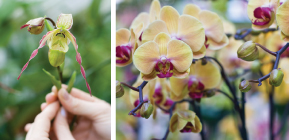
So as Jack Frost pays us a visit and you find yourself cuddling up by a cozy fireplace, gaze over at your stately orchid. Perhaps you will find a tropical paradise in the middle of your winter wonderland.






